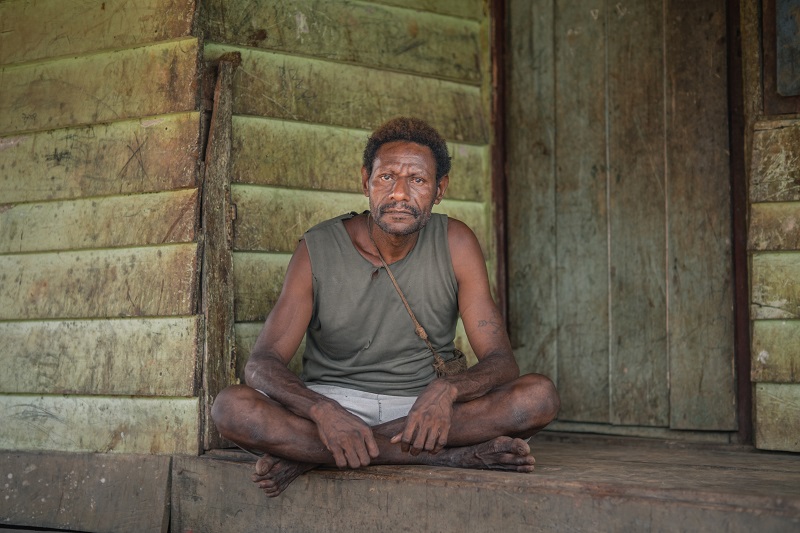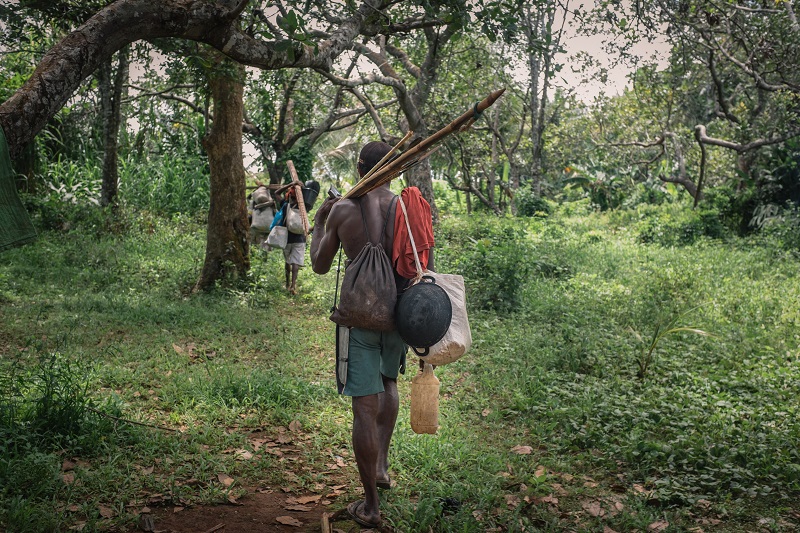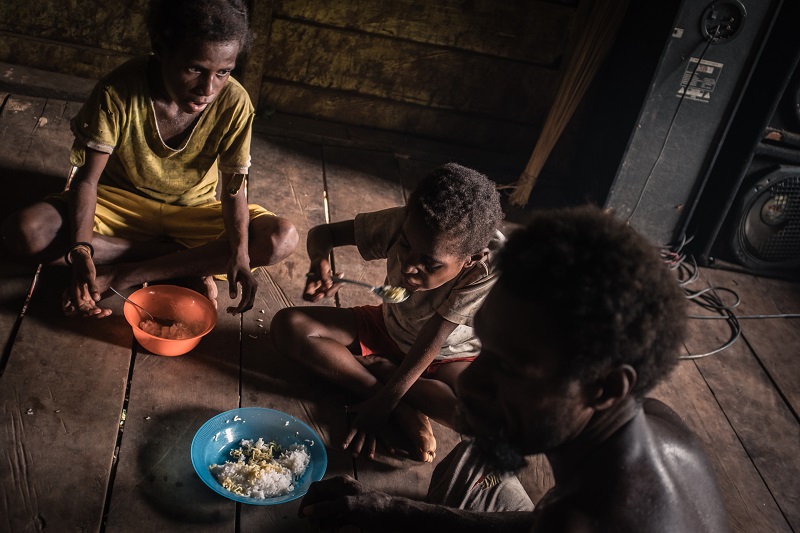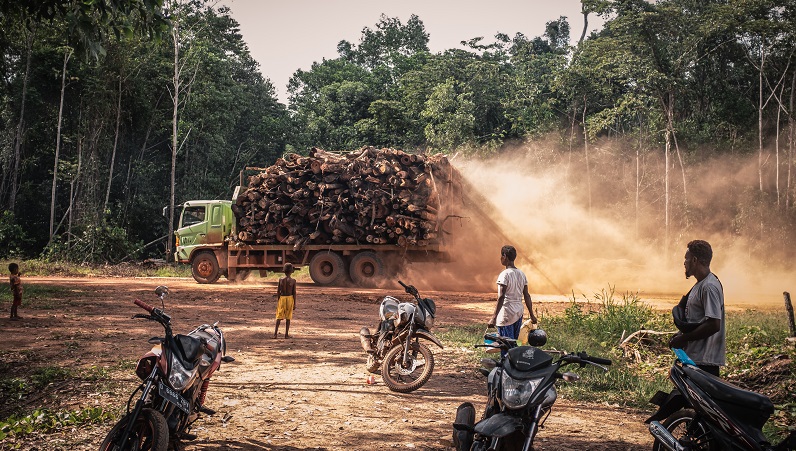Green funds have been spent cutting down trees for biomass to make electricity, decimating the traditional food sources of indigenous people
Millions of dollars in green financing intended to help Indonesia reduce its carbon emissions have been invested in a project that is destroying rainforest in Papua.
The money has been used to help an Indonesian conglomerate, Medco Group construct a biomass power plant that makes electricity from burning wood.
Medco has already cleared large tracts of rainforest, establishing timber plantations in its place.

Deforested land (Photo: Albertus Vembrianto)
As a result of the financing, it plans to expand its plantations by at least 2,500 hectares – seven times the size of New York’s Central Park – and cut down more rainforest.
The project has made it harder for Marind people, hunter-gatherers indigenous to the lowlands of Papua, to find food to eat.
With food in the shops expensive, many families are going hungry, eating meals consisting solely of rice. Children have died of malnutrition.
Rainforest to wood chips
Medco’s project started in the late 2000s, as part of Indonesia’s push to convert southern Papua into a source of food and energy.
The company’s initial plan was to plant a vast timber plantation that would produce wood chips for export.
Medco obtained a licence for some 170,000 hectares of land, overlapping substantially with the ancestral territory of Marind people living in Zanegi village.
FSC’s rehab scheme for forest destroyers under fire after fresh allegations
Before the deforestation began, villagers said, they could find food a few steps from their homes.
It was common to see cassowaries – a flightless bird similar to a turkey – in their backyards.
Boar and kangaroos roamed around the village, and the swamps were full of fish.
Early promises
Still, some villagers welcomed the arrival of Medco. The company assuaged concerns by handing out cash and promising jobs, support for children’s education and a new school, church and health facilities.
The company signed a written agreement in 2009 committing it to protect sacred places, areas of cultural importance, hunting grounds, and what Medco described as “other places considered important to the community.”
“At the beginning, it was good, because the people got jobs,” said Amandus Gebze, a Marind father of nine. “Everyone was involved in the work, there were no exceptions.”

Amandus Gebze, a Marind father of nine. Two of his children have passed away and two were suffering from malnutrition, as of April 2022. (Photo: Albertus Vembrianto)
But within a few years, the villagers were fired. The regular income Medco had provided dried up, replaced mostly with irregular work picking up small pieces of wood for $5 a cubic metre.
Asked why the employees had lost their jobs, Medco said that it stopped clearing the forest in 2014 because it was losing money. But it added that it had switched from employing staff directly, to working through “contractors or third parties.”
The company then suggested the villagers had lost their jobs because they were unable to “comply with company regulations” and were “often absent,” and were therefore considered to have resigned.
Food sources wrecked
Some villagers returned to hunting to provide food for their families. But Medco had replaced a ten kilometre wide stretch of natural forest with a man-made plantation of identical trees.
In interviews, nine villagers said it had become significantly harder to source their traditional foods.
They now had to roam up to 15 kilometres away to hunt cassowaries or deer and often returned empty-handed several days in a row.

The Marind are hunter-gatherers who sourced game from the forests around their village. Since Medco’s operations began they have been forced to travel further in search of food. (Photo: Albertus Vembrianto)
The groves of sago, which produce a starchy staple food like tapioca, had been spared from clearing. But the denuded landscape meant they’d been ruined by mud and chemicals.
With free local food sources drying up, the villagers are forced to buy food that comes in by pick-up track and often costs more than it would in a high-end supermarket in Indonesia’s big cities.
Empty rice
Without a secure income and their traditional food sources declining, some villagers told us it has become common for them to eat only rice, a meal they refer to as nasi kosong or “empty rice.”
The Gecko Project observed Amandus Gebze’s family prepare a breakfast of rice with two packets of noodles, split between the parents and six siblings.

Some families living in the village of Zanegi, in the shadow of Medco’s plantation, now regularly consume meals consisting solely of rice, supplemented by instant noodles when they have cash. (Photo: Albertus Vembrianto)
Some families will sprinkle pepper on the rice to make it edible. Others will pour salt water on it or just drink large quantities of water to help them swallow it.
In April 2022, health workers stationed in the village told the Gecko Project that four children were stunted and eight pregnant women were suffering from chronic energy deficiency, a health risk to them and their babies.
Health records obtained during an investigation by the Indonesian newspaper Kompas in August last year showed that around a third of young children measured were stunted.

A Marind child at his home in Zanegi. Marind families tend to be large, with more than 20 people sharing a single small home in some cases. (Photo: Albertus Vembrianto)
Since 2012, there have been reports of a total of nine malnourished children from Zanegi dying. Indonesian newspaper Kompas found that between 2019 and 2021, one family alone lost three children.
Not our fault
Medco rejected the suggestion that this could be linked to its project. “Medco Papua’s operations do not cause malnutrition,” it wrote. “No community food sources were disturbed.”
However, it also said that the “allegations presented by The Gecko Project regarding malnutrition incidents require further in-depth investigation”.
Medco denied making promises to the community, beyond the written agreement to protect their food sources and other key areas.
It insisted that it had made efforts to help improve the plight of the community, despite its project losing money.
Green funding boost
Medco claimed that its project’s progress was limited to 3,000 hectares of land because it was not financially viable.
This is supported by satellite imagery, which shows the forests around Zanegi being cleared rapidly after 2010, then largely stopping in 2014.
But in 2017, the Indonesian government gave Medco’s failing project a new lease of life.

A Medco truck carries wood along a road between the forest and a clearing. (Photo: Albertus Vembrianto)
It provided financing to help Medco construct a new biomass power plant 20 kilometres away from Zanegi while the state-owned electricity company committed to buying the energy it would generate.
Satellite imagery shows the new power plant emerging, 20 kilometres south-east of Zanegi, in late 2018. In 2021, it also shows deforestation resuming, north of Zanegi.
The backers – SMI
The first tranche of government funding came from PT Sarana Multi Infrastruktur (SMI), a state-owned company under the control of the Ministry of Finance.
In 2017, it provided 60 billion rupiah ($4.5 million) in “project financing” for the power plant.
SMI was established in 2009 to provide infrastructure financing, but has been increasingly focused on helping Indonesia meet its climate change commitments.
Its 2017 sustainability report suggested that Medco’s power plant could help Indonesia deliver on the United Nations Sustainable Development Goals (SDGs).
In a 2020 presentation, an SMI director presented the plant as an example of “financing to contribute towards climate change mitigation”.
This was despite nonprofits saying publicly, including to the UN, that the Medco project was making the Marind go hungry.
SMI declined to comment.
The backers – IEF
In 2021, the energy ministry and Medco said that another government fund, the Indonesian Environment Fund (IEF), had also provided “funding support” for the biomass power plant.
Budi Basuki, a senior Medco executive, said that the total funding had reached 140 billion rupiah, more than $9 million.
The IEF was established in 2019 as a body that could be used to channel investments to protect the environment.
When it received IEF’s support, Medco had already cleared an estimated 3,000 hectares of forest.
The company said it needs to almost double the size of its plantation to meet the demands of the power plant, and that it would continue to use wood harvested from the forest as it is cleared.
It also hopes to triple the capacity of the plant, creating demand for more land and wood.
Government maps show that as of 2012, large areas of its concession were intact, or “primary”, rainforest and swamp forests.
Analysis of satellite imagery by The Gecko Project indicates that the area remains largely undisturbed. These landscapes hold large amounts of carbon that are released if they are cleared.
Endah Tri Kurniawaty, of the IEF
Read More

